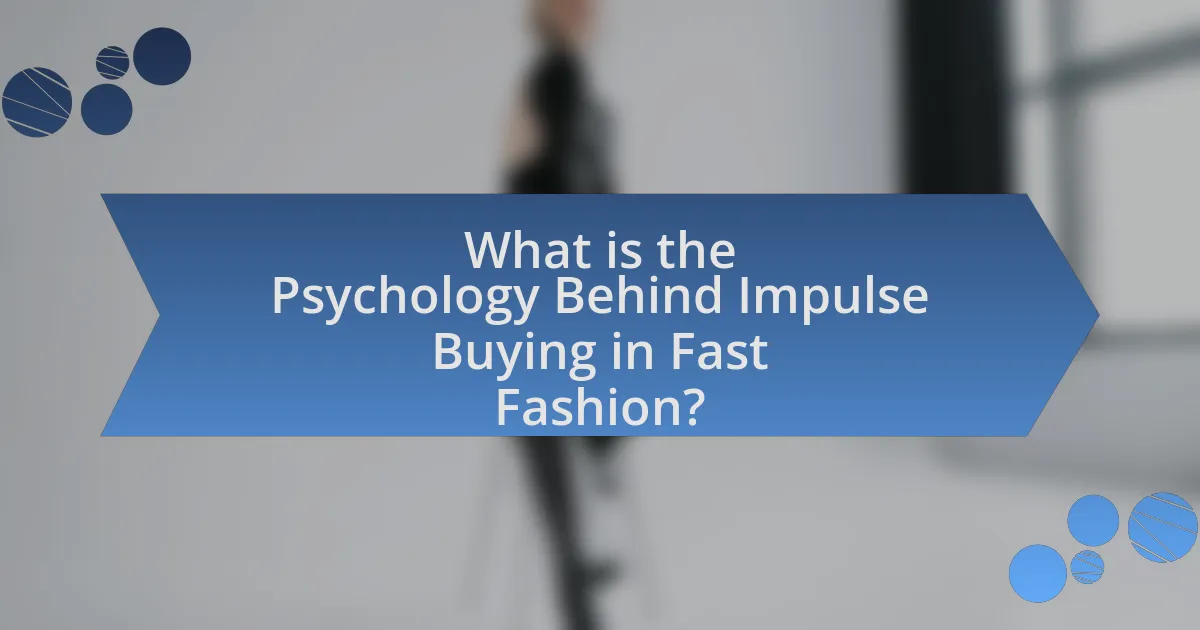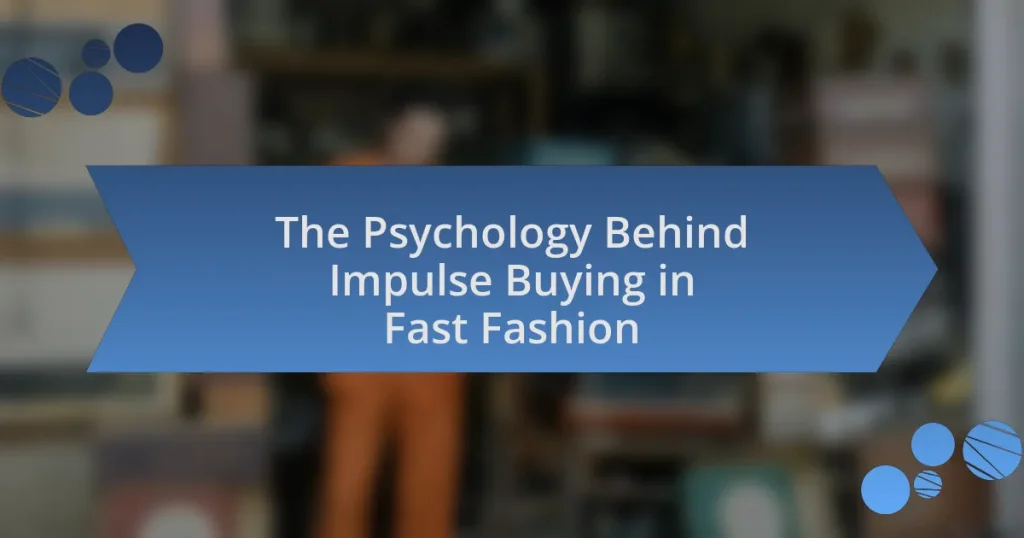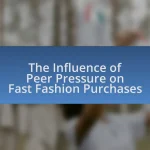The article examines the psychology behind impulse buying in the fast fashion industry, highlighting the emotional triggers, social influences, and marketing strategies that drive consumer behavior. It discusses how emotional factors such as excitement and stress, along with environmental cues and promotional tactics, lead to unplanned purchases. The impact of impulse buying on financial well-being and consumer satisfaction is also analyzed, revealing the short-lived nature of gratification and the potential for regret. Additionally, the article offers insights into how understanding these psychological mechanisms can improve marketing strategies and provides practical strategies for consumers to manage impulse buying effectively.

What is the Psychology Behind Impulse Buying in Fast Fashion?
The psychology behind impulse buying in fast fashion is primarily driven by emotional triggers, social influences, and marketing strategies. Emotional triggers, such as excitement and the desire for instant gratification, lead consumers to make unplanned purchases. Social influences, including peer pressure and the need for social acceptance, further encourage impulsive buying behaviors, as individuals seek to align with current trends. Marketing strategies, such as limited-time offers and visually appealing displays, create a sense of urgency and scarcity, compelling consumers to act quickly. Research indicates that approximately 70% of consumers report making impulse purchases, highlighting the significant impact of these psychological factors in the fast fashion industry.
How does impulse buying manifest in the fast fashion industry?
Impulse buying in the fast fashion industry manifests through strategic marketing tactics that create a sense of urgency and emotional appeal. Retailers often employ limited-time offers, flash sales, and eye-catching displays to trigger spontaneous purchasing decisions. For instance, a study by the Journal of Consumer Research found that consumers are more likely to make unplanned purchases when they perceive scarcity or time constraints, which is a common tactic in fast fashion marketing. Additionally, the use of social media influencers and targeted advertisements further amplifies the desire to buy impulsively, as consumers are exposed to curated lifestyles that promote frequent shopping. This combination of psychological triggers and marketing strategies leads to increased impulse buying behavior among consumers in the fast fashion sector.
What triggers impulse buying behaviors among consumers?
Impulse buying behaviors among consumers are primarily triggered by emotional factors, environmental cues, and marketing strategies. Emotional triggers include feelings of excitement, happiness, or stress, which can lead to spontaneous purchases as a form of self-reward or coping mechanism. Environmental cues such as store layout, product placement, and promotional signage create a stimulating shopping atmosphere that encourages unplanned purchases. Additionally, marketing strategies like limited-time offers, discounts, and social proof (e.g., customer reviews or influencer endorsements) further enhance the likelihood of impulse buying by creating a sense of urgency and desirability. Research indicates that approximately 70% of consumers report making impulse purchases, highlighting the significant impact of these triggers on consumer behavior.
How do marketing strategies influence impulse buying in fast fashion?
Marketing strategies significantly influence impulse buying in fast fashion by creating a sense of urgency and appealing to consumers’ emotions. Techniques such as limited-time offers, flash sales, and exclusive collections trigger fear of missing out (FOMO), prompting immediate purchases. Research indicates that 70% of consumers report making impulse purchases due to promotional tactics, highlighting the effectiveness of these strategies. Additionally, visually appealing displays and targeted social media advertising enhance brand visibility and desirability, further driving spontaneous buying behavior.
Why do consumers engage in impulse buying in fast fashion?
Consumers engage in impulse buying in fast fashion primarily due to emotional triggers and the influence of marketing strategies. Fast fashion brands often create a sense of urgency through limited-time offers and frequent new arrivals, which can lead to spontaneous purchasing decisions. Research indicates that 60% of consumers report making unplanned purchases when they feel emotional, such as excitement or stress, which fast fashion retailers capitalize on through appealing advertisements and in-store displays. Additionally, the low price points of fast fashion items reduce the perceived risk associated with impulse purchases, further encouraging consumers to buy on a whim.
What psychological factors contribute to impulse buying decisions?
Psychological factors that contribute to impulse buying decisions include emotional triggers, social influences, and cognitive biases. Emotional triggers, such as feelings of happiness or stress, can lead consumers to make unplanned purchases as a way to enhance their mood or alleviate negative feelings. Social influences, including peer pressure and the desire for social acceptance, can also drive impulse buying, as individuals may feel compelled to purchase items that are popular or endorsed by others. Cognitive biases, such as the scarcity effect, where consumers perceive limited availability as a signal of higher value, further encourage impulsive purchases. Research by Rook and Fisher (1995) highlights these psychological mechanisms, demonstrating that emotional and social factors significantly impact consumer behavior in retail environments.
How do emotions play a role in impulse buying behavior?
Emotions significantly influence impulse buying behavior by triggering immediate desires and reducing rational decision-making. Positive emotions, such as excitement or happiness, often lead consumers to make spontaneous purchases as a way to enhance their mood or celebrate a moment. Conversely, negative emotions like stress or sadness can also drive impulse buying as individuals seek comfort or distraction through shopping. Research indicates that approximately 70% of impulse purchases are driven by emotional triggers, highlighting the strong connection between feelings and buying decisions. This emotional response often overrides cognitive evaluations, leading to unplanned purchases in fast fashion retail environments.
What are the consequences of impulse buying in fast fashion?
Impulse buying in fast fashion leads to significant financial strain and environmental harm. Consumers often spend beyond their means, accumulating debt due to the low prices and frequent promotions associated with fast fashion brands. This behavior contributes to a cycle of overconsumption, where individuals purchase items they do not need, resulting in an average of 80% of clothing being discarded within a year of purchase. Additionally, the fast fashion industry is responsible for approximately 10% of global carbon emissions, exacerbating climate change. The rapid production and disposal of clothing also contribute to massive textile waste, with 92 million tons generated annually. These consequences highlight the detrimental effects of impulse buying on both personal finances and the environment.
How does impulse buying affect consumer satisfaction?
Impulse buying generally leads to a temporary increase in consumer satisfaction due to the immediate gratification it provides. This satisfaction often stems from the excitement and thrill associated with spontaneous purchases, which can create a positive emotional response. However, research indicates that this satisfaction may be short-lived, as consumers often experience regret or buyer’s remorse after the initial excitement fades. A study published in the Journal of Consumer Research found that while impulse purchases can enhance mood in the short term, they frequently result in lower overall satisfaction when consumers reflect on their spending habits and financial decisions.
What impact does impulse buying have on financial well-being?
Impulse buying negatively impacts financial well-being by leading to unplanned expenditures that can result in debt accumulation. Research indicates that individuals who frequently engage in impulse buying often experience higher levels of financial stress and lower savings rates. A study published in the Journal of Consumer Research found that 60% of impulse buyers reported feeling regret after their purchases, which can further exacerbate financial anxiety. Additionally, impulse buying can disrupt budgeting efforts, making it challenging for individuals to meet their financial goals.
How can understanding impulse buying improve marketing strategies?
Understanding impulse buying can significantly enhance marketing strategies by allowing brands to tailor their approaches to trigger spontaneous purchases. By analyzing consumer behavior, marketers can identify key factors that lead to impulse buying, such as emotional triggers, product placement, and promotional tactics. For instance, research indicates that 70% of purchases in fast fashion are made on impulse, highlighting the importance of strategically placed merchandise and limited-time offers to create urgency. Additionally, utilizing sensory marketing techniques, such as appealing visuals and engaging store layouts, can further stimulate impulse buying, leading to increased sales and customer satisfaction.
What strategies can consumers use to manage impulse buying?
Consumers can manage impulse buying by implementing strategies such as creating a budget, making shopping lists, and delaying purchases. Establishing a budget helps consumers set financial limits, reducing the likelihood of unplanned spending. Creating shopping lists ensures that consumers only buy necessary items, minimizing the temptation to purchase unnecessary products. Additionally, delaying purchases for a set period, such as 24 hours, allows consumers to evaluate their need for the item, often leading to a decision against the impulse buy. Research indicates that these strategies can significantly decrease impulsive spending behaviors, as they promote mindful decision-making and financial awareness.
How can mindfulness techniques help reduce impulse purchases?
Mindfulness techniques can help reduce impulse purchases by increasing awareness of one’s thoughts and emotions during shopping. By practicing mindfulness, individuals can recognize triggers that lead to impulsive buying, such as stress or social pressure, allowing them to pause and evaluate their motivations before making a purchase. Research indicates that mindfulness can enhance self-control and decision-making, leading to more deliberate choices. A study published in the Journal of Consumer Research found that individuals who engaged in mindfulness practices reported lower levels of impulsive buying behavior, demonstrating the effectiveness of these techniques in promoting thoughtful consumption.
What role does budgeting play in controlling impulse buying?
Budgeting plays a crucial role in controlling impulse buying by establishing financial limits that guide consumer spending behavior. When individuals create a budget, they allocate specific amounts for various expenses, which helps them prioritize needs over wants. This structured approach reduces the likelihood of spontaneous purchases, as consumers are more aware of their financial constraints. Research indicates that individuals who adhere to a budget are less prone to impulse buying, as they have a clear understanding of their financial situation and goals. For instance, a study published in the Journal of Consumer Research found that consumers who budgeted effectively reported lower levels of impulse purchases compared to those who did not budget.















